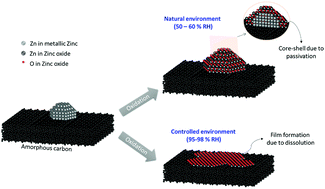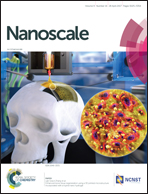Zinc nanostructures for oxygen scavenging†
Abstract
In this work, oxidation of carbon supported Zn nanostructures was studied to elucidate their utilization as oxygen scavenging materials activated by the relative humidity in the environment. Moisture-activated nano-scavengers were produced on carbon substrates using magnetron sputtering attaining nano-islands (nanoparticles), randomly distributed on the carbon surface, with arbitrary crystallographic orientations. They possess a Zn–ZnO core–shell structure, caused by surface passivation, which provides them with a self-assembled protective layer that prevents complete oxidation of nanoparticles prior to utilization. The oxidation rate is independent of the nanoparticle size and orientation, for particles between 5 and 18 nm. The oxidation kinetics are not in complete agreement with the Cabrera and Mott theory. When exposed to a high relative humidity environment, an acceleration in the oxidation process is observed, dissolving the Zn nanoparticles and forming a layer on the carbon, which facilitates the consumption of the Zn to form ZnO. These results support the idea of its potential use in applications where high RH environments are required, such as food packaging.



 Please wait while we load your content...
Please wait while we load your content...